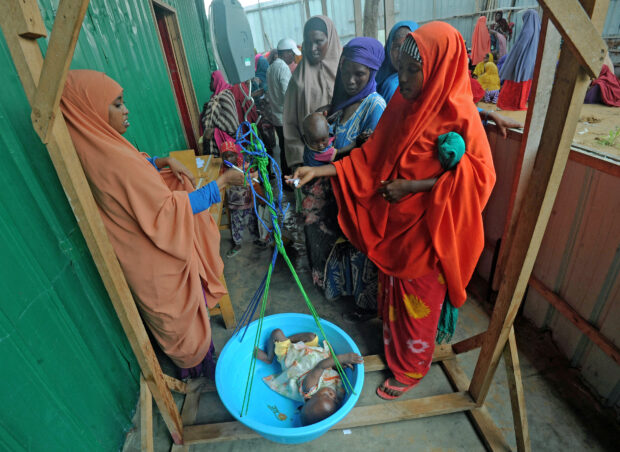
Newly displaced Somali women weigh their malnourished children as they try to receive medical treatment on the outskirts of Mogadishu on April 11, 2017. AFP
GENEVA — Nearly 130,000 people in the Greater Horn of Africa are “staring death in the eyes” from catastrophic hunger, the World Health Organization (WHO) warned Friday.
Some 48 million people in the Greater Horn — Djibouti, Ethiopia, Kenya, Somalia, South Sudan, Sudan and Uganda — are facing crisis levels of food insecurity, the WHO said.
That means households skipping meals and depleting savings and assets in order to eat.
Of those, six million are facing emergency levels of food insecurity, and 129,000 are at the worst level — catastrophe.
“They are facing starvation and staring death in the eyes,” said Liesbeth Aelbrecht, the WHO’s incident manager for the health crisis in the Greater Horn of Africa.
Of the 129,000, 96,000 are in Somalia and 33,000 in South Sudan, she told reporters in Geneva via videolink from Nairobi.
“Most parts of the region are battling the worst drought in at least 40 years while other parts have been affected by flooding, leading to widespread hunger,” she said.
“We are seeing a surge in disease outbreaks and the highest number of malnourished children in years,” she said.
Around 11.9 million children aged under five are likely to face acute malnutrition this year.
The region is facing measles, cholera, malaria, dengue, hepatitis E and meningitis outbreaks.
“The numbers of reported disease outbreaks in the Greater Horn of Africa have reached their highest-ever level this century, with health systems in most of the seven countries being hard-pressed to cope,” said Aelbrecht.
She said the frequency of these disease could be linked directly to extreme climate events.
The region is one of the most vulnerable to climate change, with crises that are increasingly frequent and intense.
Five consecutive failed rainy seasons have caused the death of millions of livestock, the destruction of crops, and forced millions of people to leave their homes to find water and food elsewhere.
“With climate change now a reality, we must prepare for such emergencies to occur with increasing frequency,” said Aelbrecht.
“For now, resources are needed to avert widespread illness and death,” she said, with the WHO asking for $178 million in 2023.
RELATED STORIES